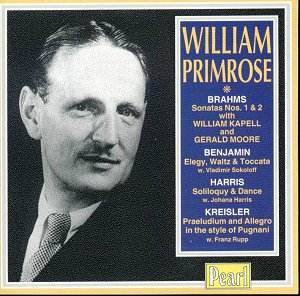Well
transferred and annotated this is a welcome addition to the current
Primrose discography. It collates the two canonical Brahms Sonatas,
in the earliest of his traversals (the Firkušny LP recordings
should certainly be restored to the catalogue however, so august
is the music making, even if one prefers the younger Primrose
at many points). It complements these with two works dedicated
to the Glaswegian by representative Australian and American composers
and adds a substantial piece by Kreisler. It was the composer-violinist
who had told his colleague Warwick Evans, cellist of the august
London String Quartet, that if he ever heard Kreisler playing
on the radio he’s know the violinist’s days were over (Kreisler,
like Rachmaninov had for years refused to play for the radio).
To Evans’ amazement one day he heard what he thought was Kreisler
– only to find out subsequently that it was actually Primrose,
then, in the later 1920s making his way as a violinist of distinction.
Fitting, then, to end with the Kreisler.
His
partners are William Kapell in the F minor, with Primrose’s phrasing
in the slow movement of wonderful simplicity and refinement, and
redoubtable Gerald Moore in the Second, in E flat major, a performance
that imbues the work with profoundly reflective intimacy. The
Benjamin triptych is notable for the surety of understanding between
violist and Vladimir Sokoloff, his most able pianist, and the
depth of rich and floated tone Primrose elicits in the opening
Elegy. His handling of the quasi-cadential passages is tremendously
impressive in its command; pizzicati spot on and in the Toccata,
the rhythmic nuances are conveyed with dazzling precision. In
Roy Harris’s Soliloquy and Dance he has the advantage of the composer’s
wife as collaborator and she proves a staunch and convincing exponent
of her husband’s music. One can but admire their handling of the
Soliloquy’s movement from pensive withdrawal to powerful and exultant
self-assertion – and the way these oppositional moods are coalesced.
Similarly they convey the wind gusts and joie de vivre stomp of
the Dance with acid drive. In the Kreisler his intonation slips
a couple of times and there’s one technical mini-buckle in the
Praeludium section but the Allegro is exceptionally brilliant
and clear – if not quite as magnetically powerful as his great
predecessor Lionel Tertis’ recording.
This
is a splendid conspectus of mid-period Primrose in repertoire
of which he was a masterful interpreter. Let’s have the Firkušny
back by all means but Primrose’s many admirers will want this
excellent all round disc, notable for quality of music making
and of recorded sound.
Jonathan
Woolf
